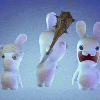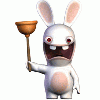
Rabbids
CBUB Wins: 0
CBUB Losses: 1
CBUB Ties: 0
Win Percentage: 0%
Added by: videogameman
Rayman is an action video game series developed by Ubisoft, originally under the direction of Michel Ancel.
Rayman games are typically platformer games, although spin offs have had radically different gameplay. The original Rayman was a 2D sprite based platformer similar to those of the 16 bit era. Rayman 2 moved the series into 3D, and added more variety to the gameplay with new actions such as riding a rocket, being pulled through a marsh by a snake, and an entire level where Rayman's hair allows him to fly instead of simply hover. Rayman 3: Hoodlum Havoc kept the same core platforming of Rayman 2, but added timed power ups and had a bigger emphasis on combat. The handheld entries in the series have remained similar to the sprite based original in gameplay in that they are 2D. Rayman DS, which was a port of Rayman 2, is an exception to that. Rayman Raving Rabbids, which was at first planned to be a traditional platformer, turned into a mini-game collection late in development after the developers got their hands on the Wii Remote and Nunchuck. Early trailers for the game and early information portray it having a darker atmosphere than is typical of a Rayman game, and show Rayman riding animals including a giant spider. Rayman could alter his appearance, and his dancing style with it, and dance to entrance the Rabbids. Ultimately this idea was scrapped, replaced with motion based mini-games similar to WarioWare: Smooth Moves. Rayman Raving Rabbids was also released on the Xbox 360, despite being made around the motion-sensing Wii controller, and simply replaced physical actions with traditional button presses. Rayman has two racing games (Rayman Arena and Rayman Rush) that feature Rayman characters racing on foot through platformer like stages, and battling in a separate arena mode. There have also been Rayman educational games, such as Rayman Brain Games, which focused less on gameplay and more on learning.
The games in the main series have fairly distinct settings (sometimes described as different realms, etc. within Rayman's home world) and plots. Nonetheless, besides the titular hero, several characters (Globox, Murfy, Ly) and themes (freeing magical beings from cages, collecting magical energy, etc.) besides the titular hero do appear with some regularity.
Particularly, the universe featured in the original Rayman has largely been left unvisited in subsequent instalments, with the exception of cameos including the famous purple plums, small harmless versions of its boss Moskito, etc. Some elements from the original game (e.g. the hunters called Livingstones, and Betilla the Fairy) will feature in the upcoming Rayman Origins, although since in the new game these characters (and its world overall) bear some visual differences, and more obviously it features Rayman's friend Globox who first appeared in Rayman 2, it is likely to be more of a reboot.
Images with a green border may be set as the character's main profile image (For images 200x200 or 300x300 pixels square).
CBUB Match Record:
| Result | Opponent | My Score | Their Score | |
|---|---|---|---|---|
| Loss | Calvin and Hobbes | 6 | to | 22 |
No Fantasy Draft Records Available


